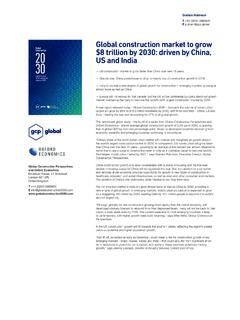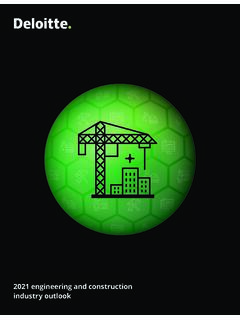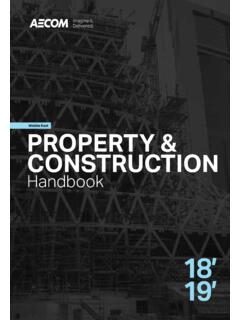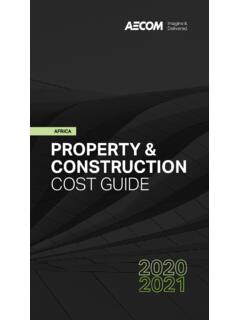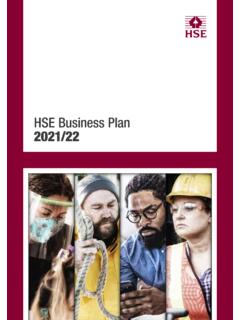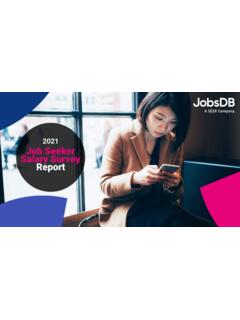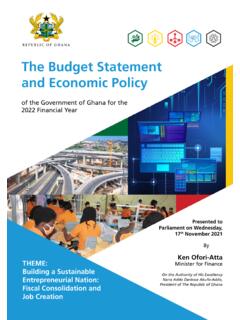Transcription of 2022 engineering and construction industry outlook
1 2022 engineering and constructionindustry outlook 2022 engineering and construction industry outlookPreparing for another strong yearThe 2020 recession was among the shortest ever, but its impact continues to be observed across both the larger US economy and the engineering and construction (E&C) industry . In our 2021 outlook , we stated that the E&C industry s strong order books and better control over its leverage and credit could lead to a quicker Indeed, the industry reached and surpassed prepandemic gross domestic product (GDP) levels by Q3 2020 and since then has been adding more than $20 billion to the economy every Total construction spending continues to remain strong, reaching record-high levels in July While the industry recovered close to million of the million jobs lost to the pandemic and maintained a strong order book,4 six in 10 firms surveyed are experiencing project delays due to workforce revenue growth for the industry is projected to be around and will likely accelerate further in Despite a positive outlook , the industry faces considerable hurdles, some new, but many familiar.
2 Among the major ones is the growing disconnect between the growth of the residential and nonresidential market segments. While the former showed a significant uptick, with building permits and housing starts at record-high levels, the nonresidential construction segment struggled for much of 2021, with spending levels significantly below The rising cost of materials and equipment and supply chain disruptions are other factors that continue to impair the industry s margins, while pervasive talent shortages are among those topics quickly rising on the boardroom agenda. Outside these, absorbing next-generation digital technologies, integrating data and analytics into workstreams, and implementing end-to-end connected construction capabilities are top of mind for 2022, as we move into the second year of recovery, the industry has a big role in supporting the nation s growth plan.
3 The Infrastructure Investment and Jobs Act (IIJA), with investments across health care, public safety, and other public infrastructure, is expected to bode well for the E&C firms and is likely to accelerate recovery across the nonresidential segment. The residential segment is expected to stay strong and exhibit similar activity as it did in 2021. The industry has increased its investments in digital, including through mergers and acquisitions (M&A), as it prepares to shift toward connected construction capabilities. These technologies can help E&C firms support initiatives such as smart cities, urban air mobility, and climate change programs and help enhance internal operational efficiencies, reduce costs, and improve margins.
4 2022 is likely to be an exciting year for the industry . Here are five themes to watch the Deloitte survey To understand the outlook and perspectives of organizations across the energy, resources, and industrials industries, Deloitte fielded a survey of more than 500 US executives and other senior leaders in September 2021. The survey captured insights from respondents in five specific industry groups: chemicals and specialty materials, engineering and construction , industrial products, oil and gas, and power and engineering and construction industry outlook3 Several factors positioning industry for strong growth amid headwindsThe industry responded very well during the pandemic and has come out strong in the recovery period.
5 Total construction spending recovered and peaked at $ trillion in July 2021, a record high for the series and 12% higher than 2019 average The Associated Builders and Contractors construction Confidence Index (CCI), which had plummeted to in March 2020, recovered and hovered at 60+ levels during the first half of 2021, signaling consistent expansion in Order backlogs stood at months in July 2021, well above pandemic-induced lows, though still below average 2019 In a recent survey (see About the Deloitte survey ), 91% of E&C respondents characterize the business outlook for their industry as somewhat or very positive, 23% higher than last year. Driving this business confidence is the expected strong performance of the residential segment and growth from the nonresidential segment due to the $1 trillion into the two segments in more detail, residential activities continued to stay strong despite rising material prices and the spread of the coronavirus Delta variant.
6 The segment posted record spending levels of about $770 billion in July 2021, 27% higher than last year and almost 30% higher than prepandemic The housing segment exhibited strong growth on the back of low mortgage rates and experienced improvements across both single- and multifamily new Provided mortgage rates remain at similar levels and no new variants surge, housing starts are likely to stay strong, further aiding residential segment growth in contrast, nonresidential segment spending growth remained weak for much of Spending across educational, office, transportation, health care, and commercial facilities observed the largest year-over-year (YoY) decline in July Overall, spending levels in July were 11% lower than prepandemic levels (February 2020).
7 16 Weakness in spending calls for additional funding for infrastructure projects, and investments through the recently approved IIJA might provide the recently approved IIJA, $550 billion in new federal investments would be made to upgrade America s infrastructure over five years, including $110 billion on roads, bridges, and major infrastructure projects, $66 billion on passenger and freight rail, $55 billion on water infrastructure, $40 billion on bridge repair, and $39 billion in public transit Additionally, the bill has other tax incentives to promote partnerships with cities and states and encourage private The bill bodes well for E&C firms and is likely to propel some growth in the nonresidential segment.
8 In addition to infrastructure work, E&C firms are likely to see a further mix of projects coming through with data centers, warehousing, and even health care likely to observe more activity than offices or commercial The bill would provide $65 billion to expand high-speed internet access; $110 billion for roads, bridges, and other projects; and $25 billion for In 2022, both residential and commercial segments are expected to present substantial opportunities for E&C companies compared with 2021, where the residential and nonresidential segments grew at different growth12022 engineering and construction industry outlook4 Supply chain disruption and sourcing challenges likely to affect project delivery and marginsDuring the second half of 2020, the pandemic exposed the vulnerabilities of global supply chains.
9 Supply issues were expected to stabilize moving into 2021 as both global production resumed and supplies normalized. However, pandemic-induced supply shortages persist, affecting key materials such as lumber, paint and coatings, aluminum, steel, and cement, among others. These disruptions are due to multiple factors, the first being pent-up demand for key materials as global construction activity resumed. For example, the Aluminum Association reported that aluminum demand in the United States and Canada totaled billion pounds through the first four months of 2021, increasing from billion pounds in the first four months of 2020, when the pandemic was Further exacerbating the situation are disruptions in the movement of materials due to increased congestion and delays at major ports such as Yantian and Ningbo in The delays are also leading to a spike in freight costs, which are on average three to five times higher than last year s The impact of this crisis is twofold.
10 The first challenge is the lack of materials; per an Associated General Contractors of America (ACG) survey, 75% of E&C firms indicated project delays due to longer lead times or shortage of Further, 57% reported delivery delays, indicating that the industry has difficulty predicting when materials would The second impact is sharply increased costs; during the first seven months of 2021, the prices of critical construction materials prices observed double-digit increases every For example, the producer price index (PPI) for steel mill products increased by more than 120%, copper and brass by 45%, plastic construction products by 30%, and lumber and plywood by all year over year in August A look at the Turner Building Cost Index (which measures costs in the nonresidential building construction market in the United States)











